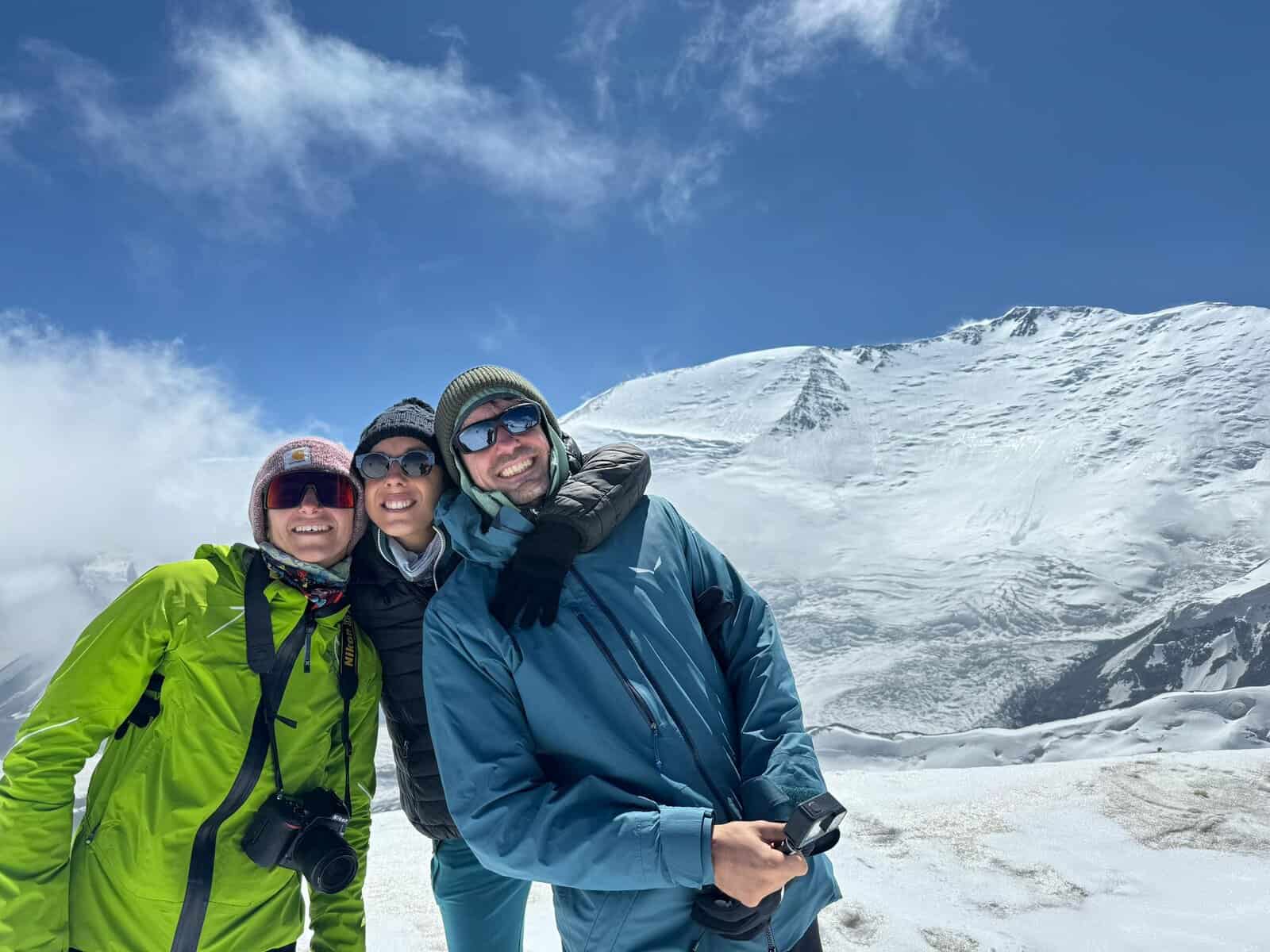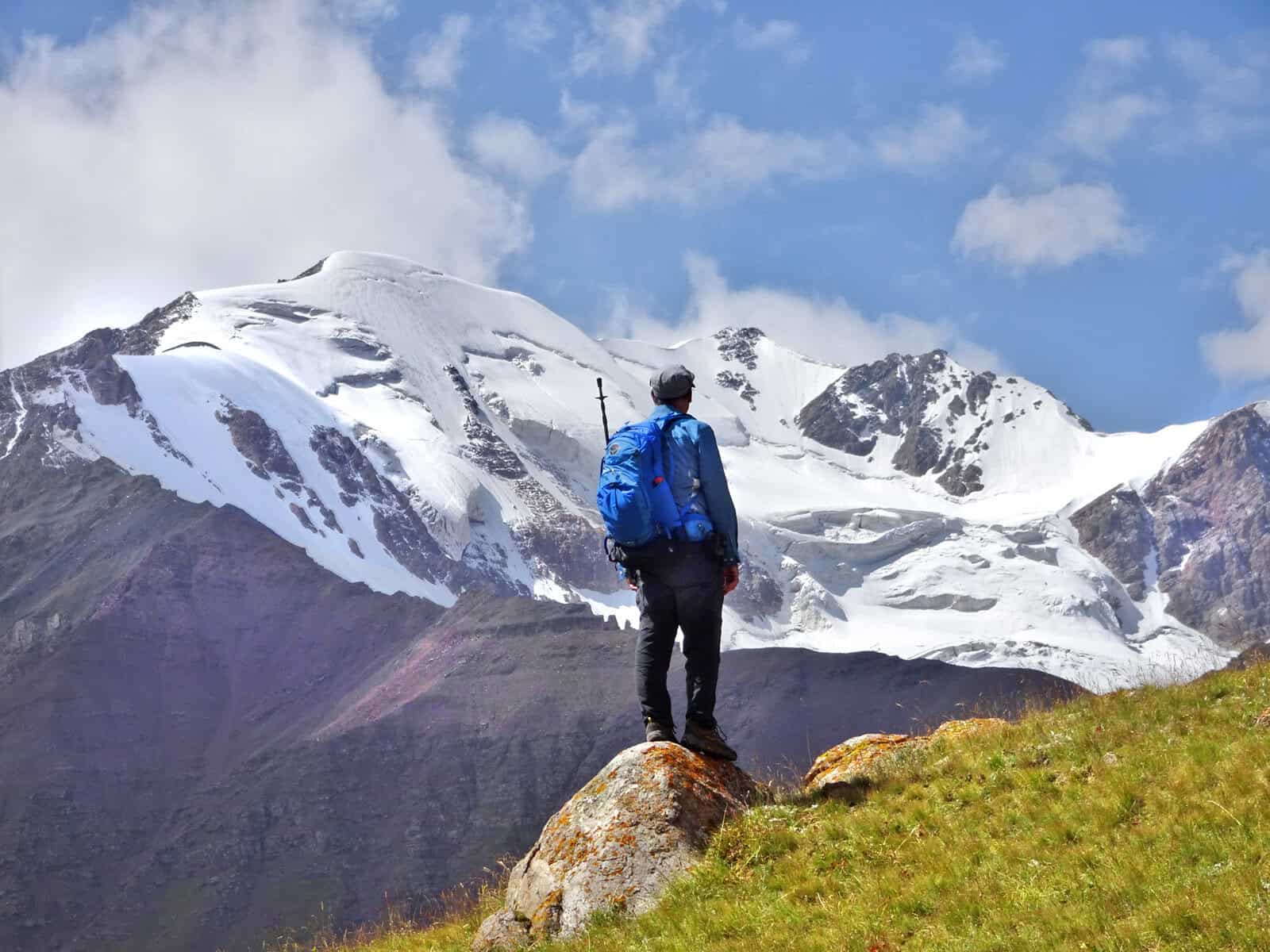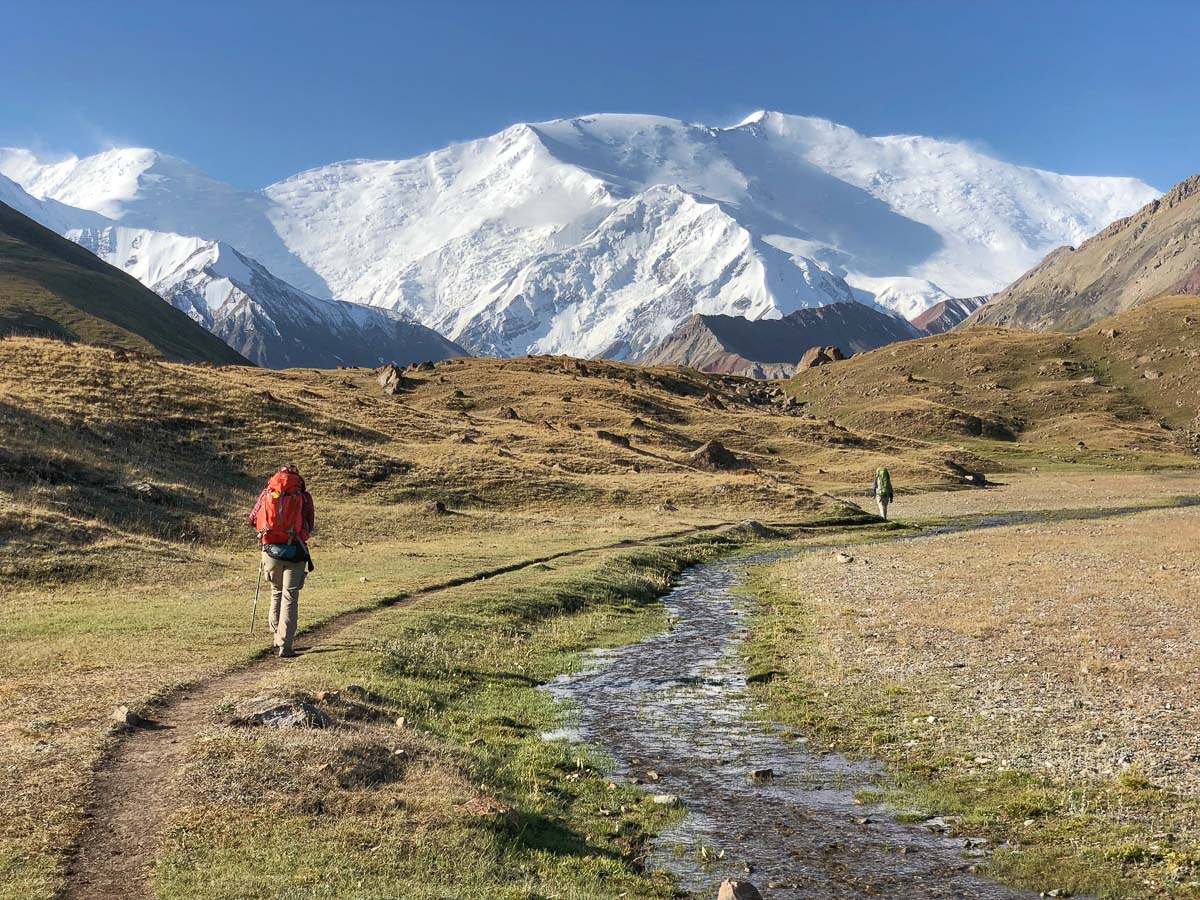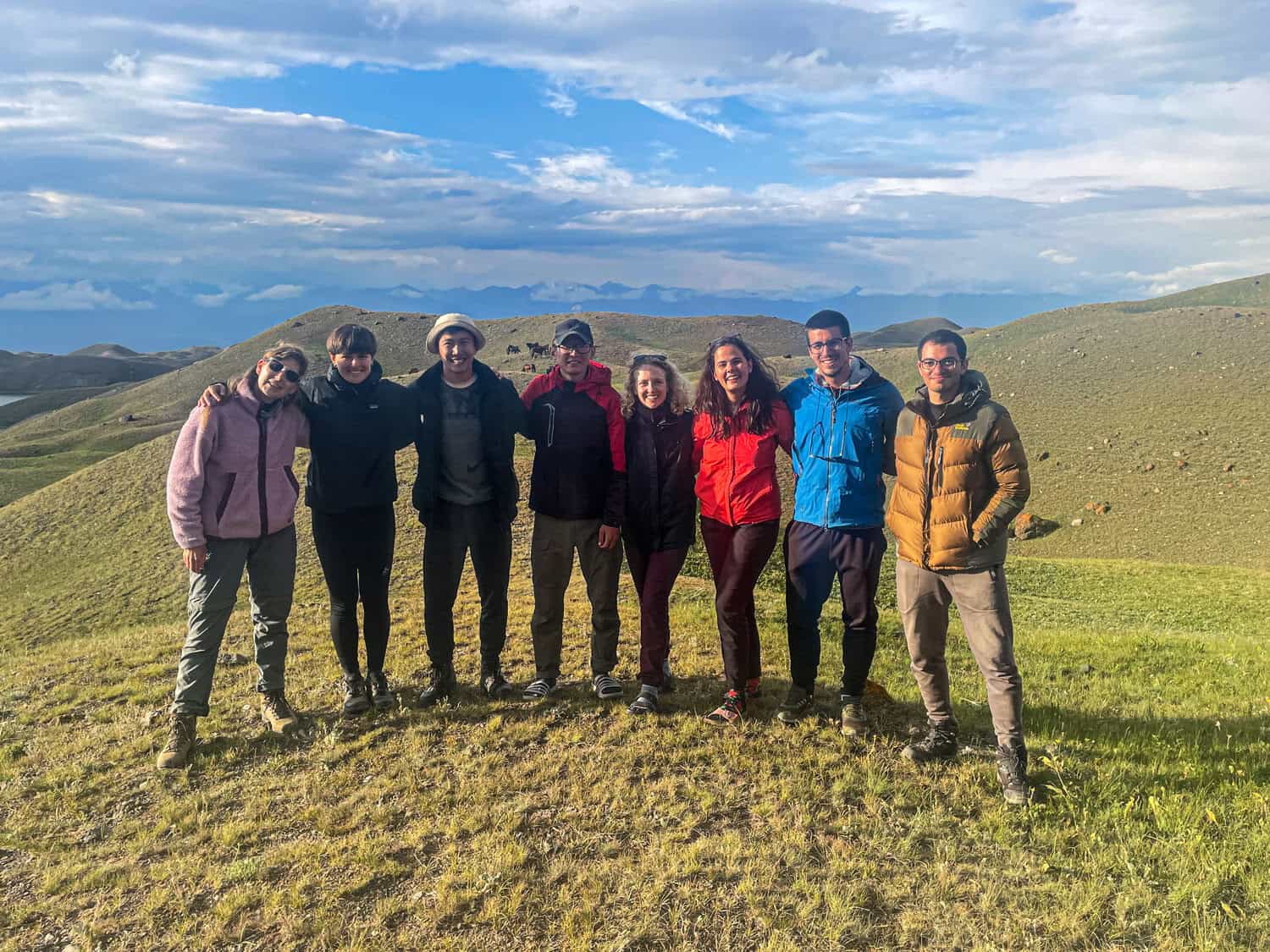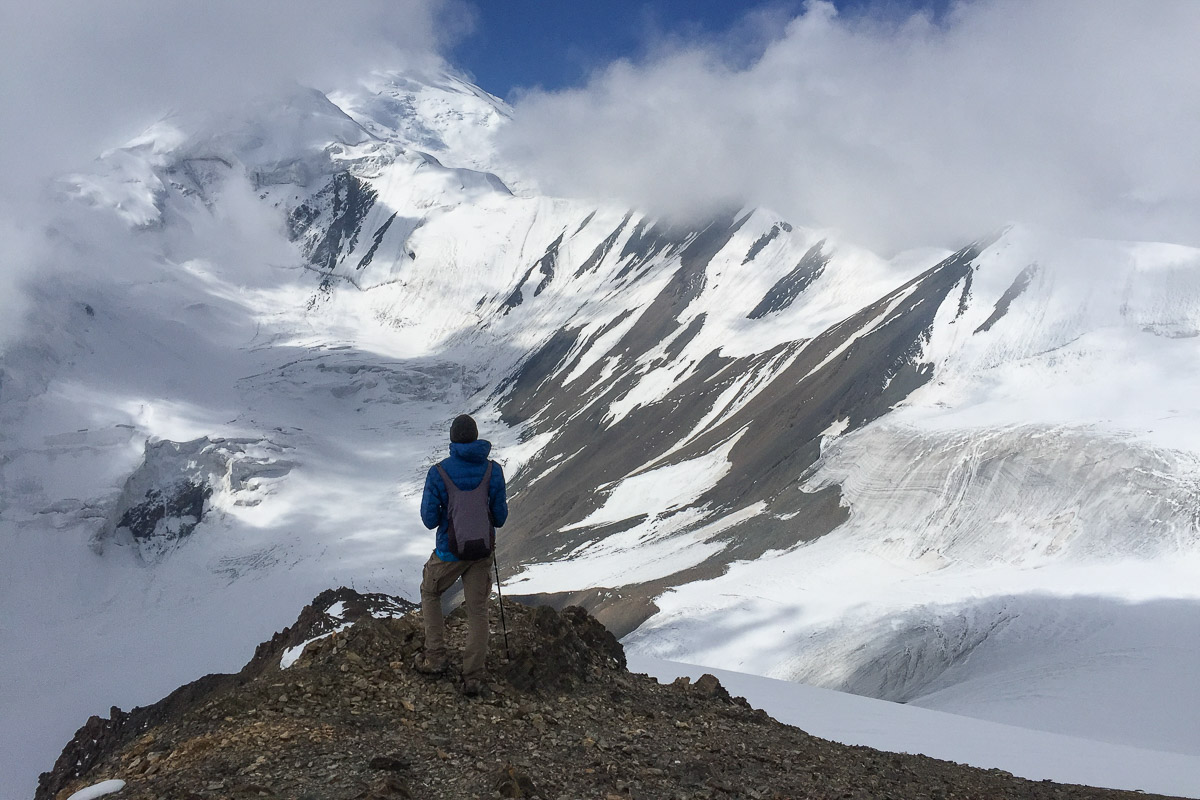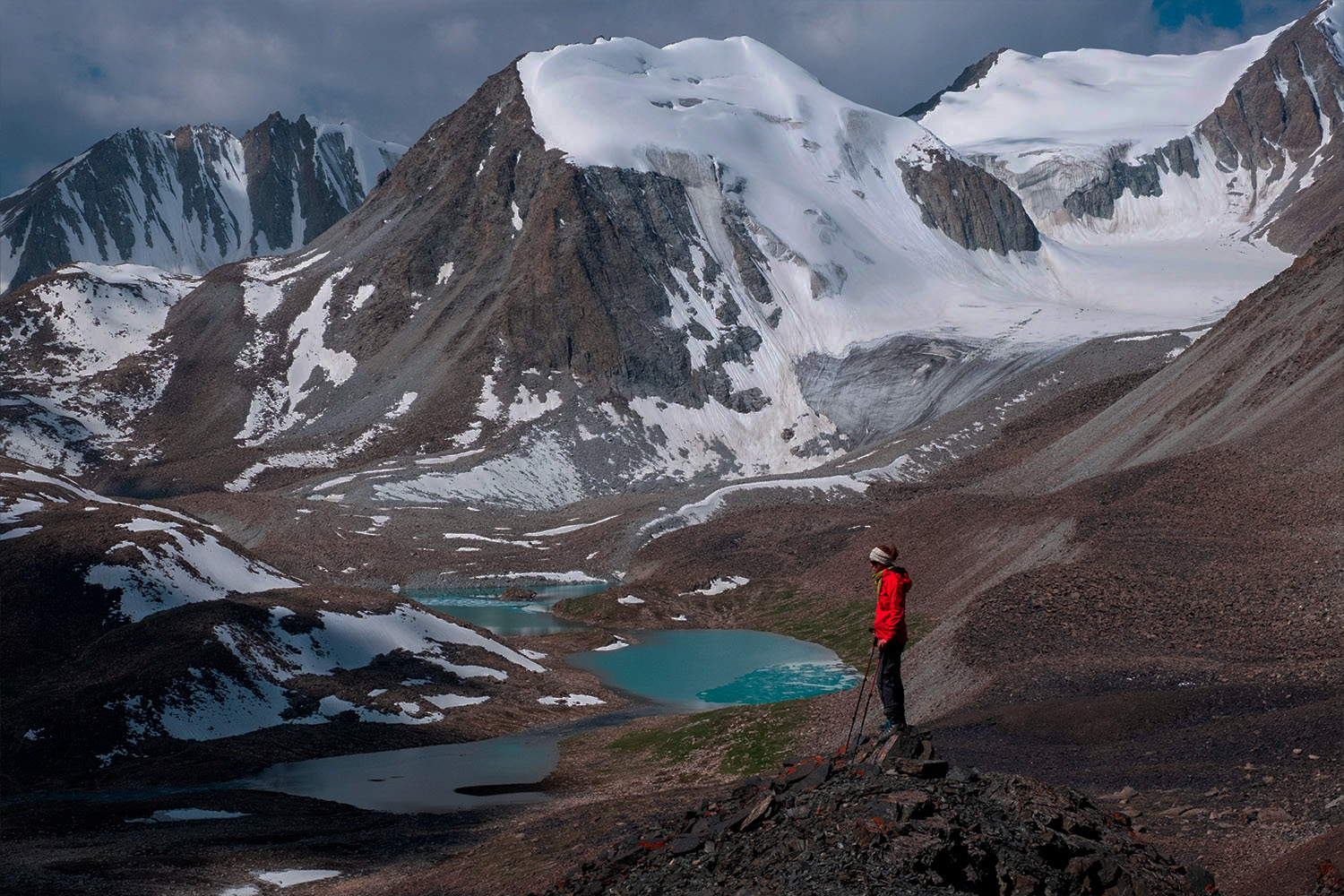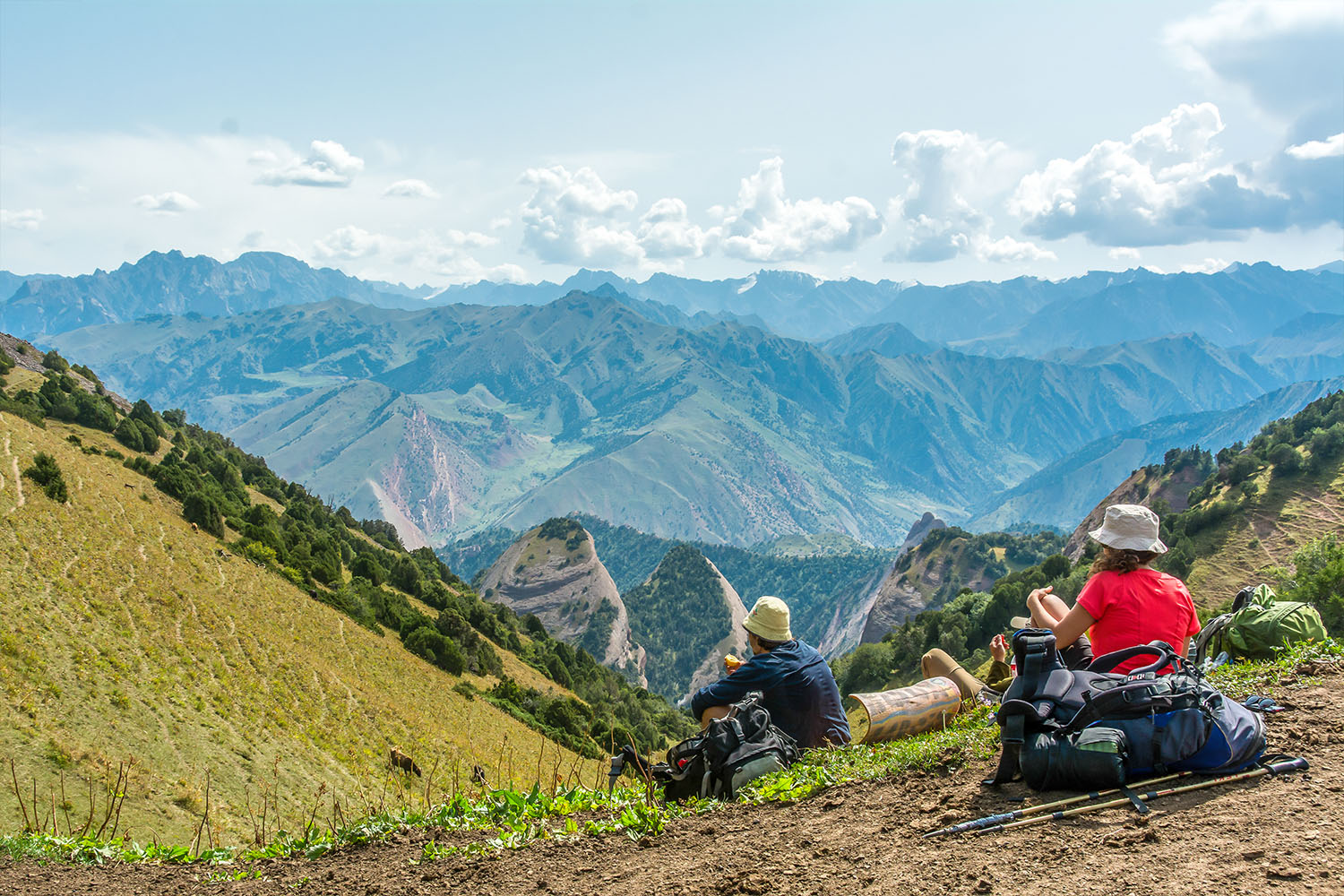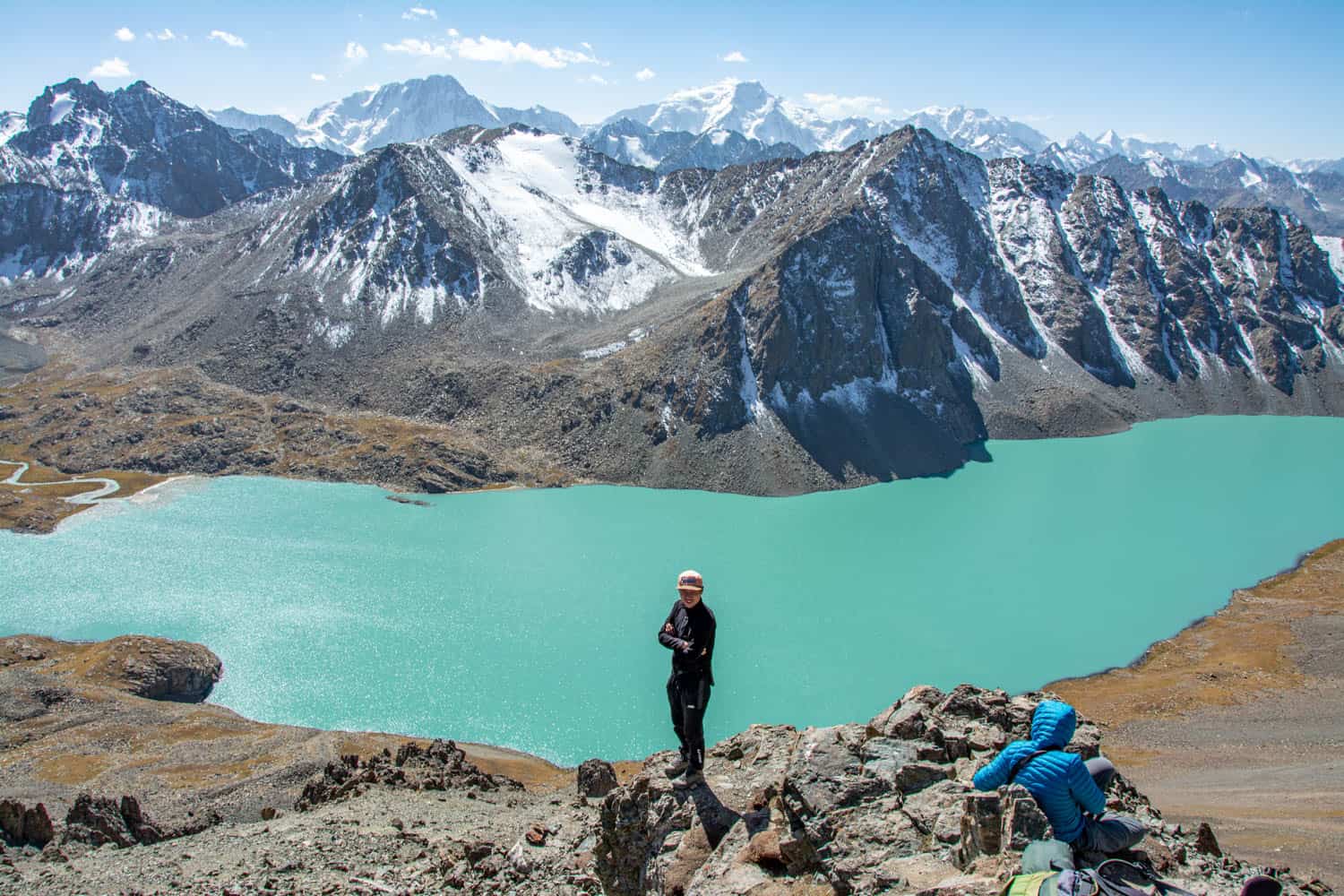Kyrgyzstan in the heart of Central Asia is a paradise for trekkers, hikers and nature lovers. Kyrgyzstan’s combination of natural beauty, rugged mountains, and nomadic culture offer an unforgettable experience for outdoor and adventure enthusiasts. And one of the best ways to discover this breathtaking beauty is on foot, through a multi-day hike or trek.
This Kyrgyzstan trekking guide highlights some of the best treks in Kyrgyzstan, from the Tian Shan to the Pamir-Alay Mountains. We also provide practical tips to help you prepare for your journey and choose the right trekking tour to match your experience, goals and interests.
Why Go Trekking in Kyrgyzstan?
Trekking in Kyrgyzstan offers an unparalleled combination of remote mountain landscapes, nomadic culture, and off-the-beaten-path adventures. With over 90% of the country covered by mountains, it’s one of the best destinations in Central Asia — and the world — for multi-day hikes, scenic horse treks, and high-altitude challenges.
Many experienced hikers compare the beauty and challenge of the treks and hikes in Kyrgyzstan with those in the Himalayan Mountains of Nepal, Patagonia in South America or the Huayhuash Mountains of Peru.
Whether you’re an experienced trekker or a first-time hiker, Kyrgyzstan has something for everyone—from glacial lakes and alpine meadows, usually including yurt stays with local families.
Top 5 Treks in Kyrgyzstan
Explore some of the best treks in Kyrgyzstan, handpicked by our local trekking experts with extensive knowledge of the the Tian Shan and Pamir-Alay Mountains.
1. Best of Alay Mountains Trek (8 days)

This signature trek in southern Kyrgyzstan includes high mountain passes (4,300+ meters), glacial valleys, and stunning panoramic views of the snow-covered Lenin Peak and Pamir Mountains. Along the way you’ll stay in family yurt camps, engage with local shepherds and find yourself surrounded by rugged and remote mountain beauty. There’s good reason why this is our most popular trek. [View Tour ➝]
2. Ala-Kol Lake Trek in the Tien Shan Mountains (4 days)

One of the most popular treks in northern Kyrgyzstan, this trek leads from Karakol to the stunning alpine lake of Ala-Kol, surrounded by snow-capped peaks. The climb over Ala-Kol Pass (3,860m) is steep but rewarding. [View Tour ➝]
3. Lenin Peak Base Camp Trek (8 days)

Get up close to one of Central Asia’s tallest peaks—Lenin Peak (7,134m)—on this moderate-difficult trek in southern Kyrgyzstan. Ideal for trekkers who want incredible high altitude scenery without technical climbing. While we won’t take you to the top of Lenin Peak (7,134 meters / 23,405 feet) on this trek, you’ll get pretty close when you overnight at Peak Lenin Base Camp (4,400 meters / 14,435 feet) and hike to nearby Yuhina Peak at over 5,130 meters / 16,830 feet. [View Tour ➝]
4. Turkestan Mountains / Asian Patagonia Trek (11 days)
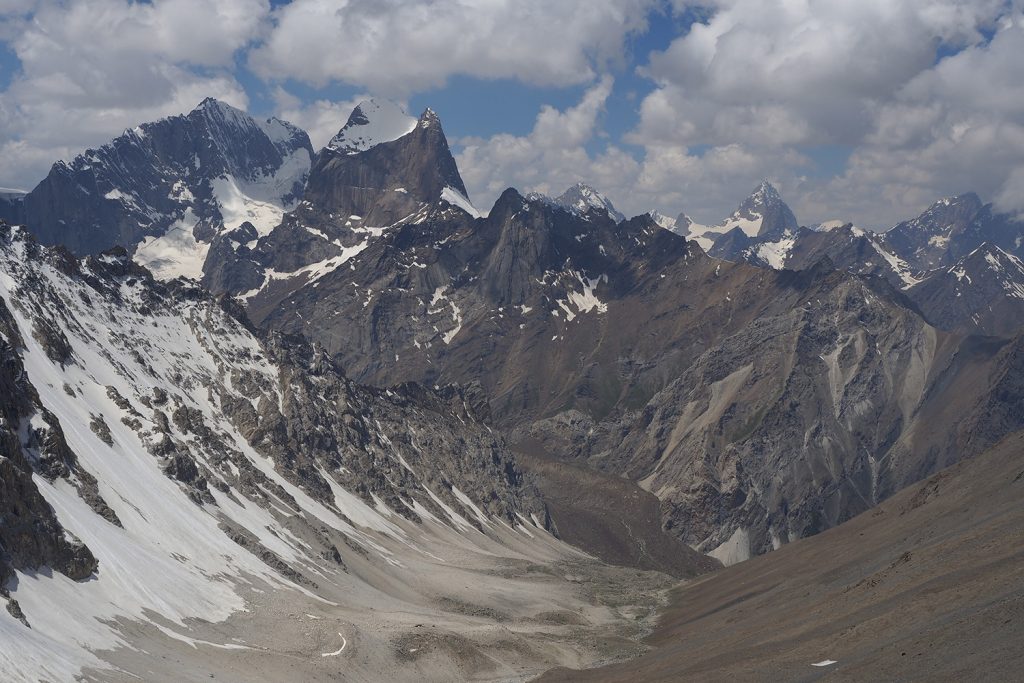
The Asian Patagonia Trek opens the scenic and glaciated views of Turkestan Mountains that are part of the Pamir Mountain Range. These mountains and trails are still unknown…for now. This off-the-beaten-track tour combines some of the best landscapes, trekking and nomadic cultural experiences in all of Kyrgyzstan. [View Tour ➝]
5. Scenic Ak Tor Pass Trek (3 days)
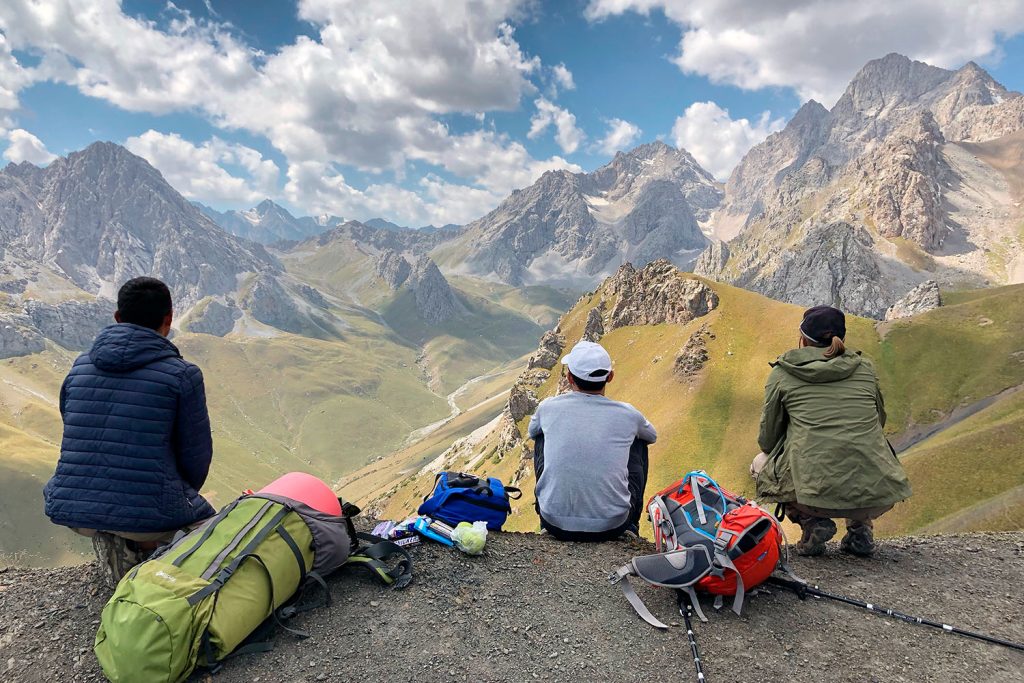
Discover the heart of Kyrgyzstan’s nomadic culture on the Scenic Ak Tor Pass Trek. This trek provides an easier hiking experience in southern Kyrgyzstan while still enjoying remote, wild mountains with the magnificent scenery of Ak Tor Pass (3,500+ meters). [View Tour ➝]
Photo Gallery of Visit Alay Trekking Tours
What to expect when trekking in Kyrgyzstan?
- Yurt stays and camping: Depending on the trek, you’ll stay in traditional yurts or camp under the stars.
- Local guides: All our treks include knowledgeable local guides.
- High altitude and mountainous terrain: Most treks are between 2,500 and 4,000 meters with a few treks that go up to 5,100 meters. Be prepared for steep ascents, but our guides are there to help you navigate the mountainous terrain and high altitudes.
When hiking in Kyrgyzstan, expect vast, mountain landscapes with few other travelers, This allows you to easily immerse yourself in nature and nomadic culture.
How to Plan and Prepare for Your Kyrgyzstan Trek
- Best time to trek or hike in Kyrgyzstan: Mid/late June to early September is the ideal trekking season. Some treks have even shorter hiking seasons due to high mountain passes that have snow sometimes until early July. Be sure to check the details of the trek you are looking at.
- Permits: Permits are needed for some treks in the Pamir-Alay Mountains, but we will take care of this for you when you book a trek with us. Permits are not needed for most treks in the Tian Shan Mountains.
- Fitness and Altitude Sickness: Moderate fitness is sufficient for most treks, but check the details for each individual trekking tour. We recommend drinking lots of water and hiking slowly to help with acclimatization for higher routes.
- Booking: We recommend booking your trekking tour several months in advance to ensure availability of guides and transport. You can book a private tour or join one of our group tours.
- See the FAQ below for more details on how to prepare and pack for a trek in Kyrgyzstan.
Kyrgyzstan Trekking Tours by Visit Alay
We offer a wide range of Kyrgyzstan trekking tours, from short 3-day hikes to 10+ day trekking expeditions. You have the option to book a private tour for any date during the trekking season you prefer or you can join one of our group trekking tours. All our trekking tours are led by local, trained mountain guides and include transport, accommodation, and gear rental options.
Reviews of Visit Alay Kyrgyzstan Trekking Tours
We undertook a modified 14 day ‘Epic Kyrgyzstan Trek’ in the Tian Shan Mountains and the Pamir Alay Mountains with Visit Alay. We went as a father-daughter pair, with a tailor-made itinerary, and everything about the trek (with but a few hiccups) was exceptional. We recommend Visit Alay and their products and service unreservedly.
Our trek was in 3 parts.
Part 1 was a trek in the Tian Shan Mountains. Our route was Bishkek-Karakol- Karakol Gorge Campsite- Ala Kul Lake- Altyn Arashan Valley via Ala Kul Pass (4000m). All aspects – pickups, transport, accommodation and support crews – were exceptionally well-organised. It was arduous but so rewarding; the scenery is breathtaking. One of us (dad; age 70!) was a bit slow, but our guides and porters were very understanding and helpful.
Part 2 was a combination of driving and resting. We had two days and two nights at Bel Tam yurt camp on the shores of Lake Issyk Kul, resting and swimming. Internet connections were excellent, so it was a great chance to catch up with family and friends. We then had two nights at Song Kul Lake (3000m). Thence onto Osh via Karzaman and Moldo Pass by car.
Part 3 was a 3-day ‘Be a Nomad Horse Trek’, which was tailor-made for us. Two days were on horseback, and the third day a rest day. Overnight was in yurts with mountain families, who looked after us exceptionally well. Day 1 we left Osh early for Gulcha, and then saddled up for a 5-hour journey to Tepshi Yurt Camp. Day 2 was a 5-hour ride over Airy Bell Pass to Sary Oyi Village/Yurt camp, where we spent 2 nights. We spent our third day walking in the mountains around Sary Oyi (Germe peak; 3000m) and playing Uno with the family! Then back to Osh for a flight back to The Netherlands.
We had to modify our itinerary as one of us (Richard, the dad!) had mild altitude sickness during Part 1, going over the Ala Kul pass at ca. 4000m. As a consequence, we decided not to risk the scheduled part 3 – the trek from Osh-Kojokelen Village to Beshkol Camp and over Sary Mogol Pass and Travellers Pass, and back to Osh, as this involved two passes at 4300m and 4100m. So we organised with Visit Alay HQ to do a 2-day horse trek, with the additional day in nature at the Sary Oi yurt camp. Rearranging our itinerary, and all the consequent questions we had about accommodation and pickups, was never a problem. All of our questions/requests answered swiftly by the team at Alay.
One of us (Emma, the daughter) had specialised dietary requirements (coeliac/gluten-free) and this was accommodated as much as possible. The country is varied in terms of safety for coeliacs, and the hardest part was in restaurants. However, at the shepherd yurts and small home-stays the owners were extremely helpful and accommodating, checking each ingredient and preparing GF food separately. Stick to home stays and yurts if you’re coeliac so you can personally make contact with the (very kind) people making your food.
In addition, we were pleasantly surprised that western toilets were often available!
Cheers and happy travels. Richard (Australia) and Emma (The Netherlands)
Date of experience: August 2025
These are some tough hikes, but very manageable. I was the slowest hiker in our group by far, but Baiysh (lead guide) was strategic in stopping the group at the most scenic viewpoints, where they could take pictures and I could catch up. On steep downhill areas where I felt unsteady there was always Baiysh, Shadi (guide for the second portion), or a porter that were there to literally lend a hand. I am so glad that the second portion had horses to carry our items — our horsemen Nurlan and Sherlik were dependable.
Our lead guide, Baiysh, was one of the best guides I’ve ever had! Supportive, knowledgeable, adaptable. He was always sharing bits of Kyrgyz culture, interacting with everyone in such a respectful way, and was able to problem solve masterfully when our car broke down — there was no delays in the schedule at all. Shadi, our guide for the second portion, was also so supportive and knowledgeable. He was able to answer all of my never ending questions and also anticipate problems before they even arose. The two were such a dream team — one of our trek members has a birthday on our last day of hiking and these 2 somehow managed to get a cake and candles to our remote yurt camp and throw a dance party.
Please do this tour if you get the chance!
Date of experience: August 2025
FAQ: Practical Information about Trekking and Hiking in Kyrgyzstan
Yes, there are a few cultural considerations to keep in mind when hiking and trekking in Kyrgyzstan in order to be respectful of local people, culture and traditions. For example, be sure to remove shoes before entering a yurt or a home. Additionally, always ask for permission before taking photographs of people, their animals and their belongings.
If you visit a mosque or other religious place, it’s essential to dress modestly and for women to cover their heads.
Visit Alay offers the option of both private guided tours as well as group tours (up to 8 people) for its trekking tours in the Alay Mountains. Both options include an experienced local guide, transportation, accommodation, most meals and other support services.
For group departures for the Best of Alay Mountains Trek, you can see the available dates above.
For private tours, get in touch with us to let us know which tour you are interested in and for which dates. We’ll respond immediately with all the details you need.
Yes, we provide secure storage for any luggage you don’t need on the trek and this service is free for our clients. For instance, if you have a suitcase or extra clothes for after the trek, you can leave them at our Osh or Bishkek office. You can also choose to leave your luggage at your hotel or guesthouse in Osh or Bishkek if that is more convenient for you.
Organized big groups will leave their luggage at the hotel or guest house.
Yes, certain border regions of Kyrgyzstan that are close to the Tajik, Uzbek or Chinese borders require special permits to visit. For example, to hike to Lenin Peak Base Camp in the southern Pamir-Alay Mountains near the Tajik border, a Kyrgyz Border Zone Permit is officially required. This permit costs around $15 for the regular application time (1-3 weeks) and $30-$50 for expedited services (e.g., 1-3 days).
Visit Alay includes the application process and cost of the permit (for regular speed applications) as part of the tour cost for treks to Lenin Peak Base Camp or if your tour goes to another location that requires a permit. We ask for a copy of your passport at the time that you book your tour in order to apply for your permit.
If you are going to Lenin Peak Base Camp or another border zone not on one our tours, be sure to apply for your permit several weeks in advance through a local tour company.
Note: Although many travelers visit places like Tulpar Kol Lake and Lenin Base Camp without being checked, we strongly advise that you have the permit to avoid any issues with military border guards.
It’s recommended to have some level of physical fitness for a medium to difficult multi-day trek or hike in Kyrgyzstan as many involve hiking at high altitudes and on steep terrain. A good level of fitness and stamina will help you enjoy the trek and moving slow and steady will help avoid altitude sickness.
For our standard tours, you don’t need any technical gear or climbing equipment — just your personal clothing and regular hiking gear (see below for this). We provide camping equipment (tents, mats) on trekking tours and riding gear on horse treks. However, depending on your activities, there may be a few extra things to consider bringing:
- Sleeping bag: Recommended for treks for extra warmth and comfort. If you don’t have one, we can rent one to you ($6/day).
- Headlamp/flashlight: Very useful for any tour that has yurt stays or village overnights where there is often limited electricity.
- Power bank: If you have cameras/phones, a portable charger helps on multi-day stretches without power.
- Trekking poles: Optional but very helpful on hikes. We have some for rent, but if you have a favorite pair, bring them.
- Riding helmet: If doing horse riding and you want a helmet. This is not provided as part of our horse tours, but we can try to source one for you.
- Water bottle with filtration and purification: We supply safe drinking water on our tours, but some travelers like to use their own filters for additional protection. Consider something like Grayl Water Bottle or LifeStraw Water Bottle.
- Specific snacks or electrolyte mixes: We provide basic snacks, but if you have special energy bars or electrolyte drinks you like then bring a few along.
- Adapter: Power outlets are European two-pin round plugs (Type C/F) in Kyrgyzstan/Tajikistan, so bring an adapter if your chargers use a different system.
No, you don’t need to bring tents or cooking gear – we provide all communal camping equipment on our organized treks.
Our trekking tours typically include tents, sleeping pads, cooking stove, and utensils when camping is required. Many of our treks in Kyrgyzstan use established yurt camps or homestays each night, so you may not camp every night – but when we do camp, we handle all the gear. You will need to bring your own clothing and personal items, as well as a sleeping bag (you can rent one from us if you prefer). Essentially, you should pack as if you’re backpacking (clothes, boots, etc.), and we’ll take care of the rest: setting up tents, preparing meals, etc. If you have favorite personal gear (like a special lightweight sleeping pad or camp pillow), you’re welcome to bring it, but it’s not necessary. This full support means even if you’re not an experienced camper, you can enjoy nights under the stars without worrying about the logistics.
No, our Lenin Peak Base Camp Trek is a high-altitude trekking tour in the Pamir-Alay Mountains that does not include a summit climb of Lenin Peak (7,134 m). Climbing to the summit of Lenin Peak is a technical mountaineering expedition requiring special gear, permits, and 2+ weeks of time. Our trek, by contrast, is designed for regular hikers who are not trained mountaineers or climbers.
As part of our Lenin Peak Base Camp Trek you’ll hike through the Pamir-Alay mountains to reach Lenin Peak Base Camp One (4,400 meters) and spend a night in tents. The Base Camp enjoys stunning close-up views of the 7,000m peak above. We also usually include a day hike to Yuhina Peak (5,130 meters), which is the highest point you’ll hike to.
Yes, all of our trekking and hiking tours in Kyrgyzstan are fully guided and supported tours. This means you will always have a mountain guide during the trek to guide and support you along the trail. Our experienced guides have at least three year’s guiding experience and will provide you with all the necessary information you need for the trek and guide you along the hiking trails. They will be with you at all times to make sure everything is OK, safe and provide support if you need additional help. All the guides speak a good English and little bit of Russian.
The Best of Alay Mountains Trek is a fully guided tour with an expert guide, horsemen, and horses to carry luggage/gear. This means that all you need to do each day is enjoy the stunning scenery and experience without worrying about getting lost, where to eat and sleep, and carrying heavy gear. All of that will be taken care of you by us.
Please see above for a full list of what services are included in this trekking tour.
Yes, all of our trekking and hiking tours in Kyrgyzstan are fully guided and supported tours and that includes this guided Peak Lenin Base Camp Trek (8 days). This means you will always have a mountain guide during the trek to guide and support you along the trail.
Our experienced guides have at least three year’s guiding experience and will provide you with all the necessary information you need for the trek and guide you along the hiking trails. They will be with you at all times to make sure everything is OK, safe and provide support if you need additional help. All the guides speak a good English and little bit of Russian.
The Peak Lenin Base Camp Trek includes an experienced mountain guide, horsemen, horses to carry luggage/gear (until Tulpar Kol Lake), and transport transfers. This means that all you need to do each day is enjoy the stunning scenery and experience without worrying about getting lost, where to eat and sleep, and carrying heavy gear. All of that will be taken care of you by us.
Please see above for a full list of services included in this trekking tour.
The difficulty level of our hiking and trekking tours in Kyrgyzstan varies depending on the route, altitude and condition of the trail. Some hikes are suitable for beginners with an easy or moderate level of difficulty, while others are quite challenging and require good fitness levels, prior trekking and hiking experience at altitude.
You don’t need any prior trekking experience. For those treks that are rated medium to difficult this means you should be in decent physical shape and ready for some long hiking days and high-altitude passes. You don’t need technical climbing experience or special equipment; our multi-day treks are essentially extended mountain hikes with no ropes or vertical climbs.
Many of our hikes and treks in the Pamir-Alay Mountains and Tian-Shan Mountains fall into the medium to difficult range, but don’t let this scare you away. Our experienced guides are used to working with trekkers of all backgrounds and we also have luggage horses on many trekking tours that can provide support to go over a mountain pass or a steep ascent.
We recommend that you research the trekking and hiking tours and routes above in detail (each tour page provides the difficulty level, length in km, and maximum elevation) and determine whether it’s suitable for your fitness level and experience. You can always get in touch with us and we can provide advice as to which trek or hike in Kyrgyzstan would suit you best.
The Best of Alay Mountains Trek is one of our most popular trekking tours, and for good reason. We rate the Best of Alay Mountains Trek as Medium-Difficult because it is quite challenging in some parts, especially the rocky and scree-covered trails before and after Sary Mogol (4,306 m) and Jiptick Pass (4,185 m). In addition, the trek goes to some high altitudes with three mountains passes over 4,100 meters, which can also be difficult if you don’t have prior experience hiking or trekking at altitude. Taking time to acclimatize before and during the trek is very important to avoid altitude sickness.
Therefore, we recommend that you are reasonably fit with some trekking experience to undertake the entire trek without any issues. Even if without a lot of trekking experience, we let anyone join the Best of Alay Mountains Trek and help them do the difficult parts on horses as our tours always include luggage horses that can be used in this purpose.
The Alay or Alai Mountains in southern Kyrgyzstan are most easily reached from the city of Osh. All of our treks and tours in the Pamir-Alay mountains depart from Osh and transportation from Osh is included in the tour price. You can find full details about transportation to Osh here from Bishkek, Uzbekistan, Tajikistan or China.
Flights to Osh
It’s becoming much easier to get to Osh by flight now as there are more and more airlines flying directly into Osh (OSS) airport in southern Kyrgyzstan. You can now find direct flights to Osh from Istanbul, Dubai, Kuwait, Sharjah, and other international cities. This is in addition to regular flights from Bishkek to Osh (45-60 minutes). We can help you book domestic flights from Bishkek to Osh if you need it.
Transport from Bishkek to Osh and the Alay Mountains
It’s also possible to travel overland from Bishkek to Osh. It is a beautiful journey going through Jalal-Abad region, but it takes around 10-12 hours. Private taxis from Bishkek to Osh can be arranged through tourism agencies and cost around $150 per car. You can also book a private transferfrom Bishkek to Osh with us.
Shared taxis are located at Bishkek’s central bus station (avtovaksal) and the Osh Bazaar. They depart when full and take eleven or more hours to complete the route. Price per seat in a shared taxi ranges from $17 to $20 (1200 to 1500 KGS).
It is always a good idea to do some physical training in advance so you can fully enjoy your trek. Cardiovascular fitness and leg strength are the most important. We recommend you start taking regular hikes or long walks in the weeks (or months) leading up to the trip. Gradually increase distance and carry a daypack to simulate the trek conditions. If you don’t have hills nearby, stair climbing or using a treadmill/incline trainer at the gym helps build uphill stamina. Aim to be comfortable walking 5-6 hours in a day.
Be sure to break in your hiking boots ahead of time so that they are comfortable and don’t give you blisters. In other words, don’t arrive with brand-new shoes.
Even if you can’t train much before your trek, don’t worry. Our experienced guides are very patient and will adjust the pace to the group. Having done a bit of prior training, however, will increase your enjoyment and reduce soreness.
The Pamir-Alay Mountains have some high mountain passes (over 4,300 meters) and trails, so it’s important to be take precautions against altitude sickness, especially if you don’t have prior experience trekking or hiking at altitude.
Some of our clients come directly without doing any high altitude adaptation. They just start the trek one day after they arrive in the country. It affects their sleep and causes headaches during the trek. However, all of our customers manage to do the trek even though they get high altitude issues thanks to the support of our expert trekking guides.
However, it’s possible to take some simple steps and precautions to avoid altitude sickness for a more enjoyable experience. These recommendations apply to the Best of the Alay Mountains Trek and any of our high altitude trekking tours.
Recommendations to Avoid Altitude Sickness
- Rest for at least one night in Osh after your international flight: This is important if you are traveling a long distance and have jet lag. Starting the trek rested will help your body adjust to altitude in the next days.
- Acclimatize with a lower elevation hike or trek first: We highly recommend you to take a trek at 2000-2500 meters around Kyrgyzstan before this trek. We have other horse treks or treks by foot at lower altitude if you plan to take them.
- Drink lots and lots of water: One of the best ways to combat altitude sickness is by drinking lots and lots of water. Try and start and end your day by drinking a liter of water. Your body will be thankful for it.
- Move slowly when trekking or hiking at altitude: A slow and steady pace walking up hills and when climbing up to high mountain passes is the best way to not tire yourself out and also allow your body to adapt to the higher elevations.
The Pamir-Alay Mountains have some high-altitude mountain passes (over 4,000-5,000 meters) and trails, so it’s important to take precautions against altitude sickness, especially if you don’t have prior experience trekking or hiking at altitude.
This Peak Lenin Base Camp Trek has four mountain passes over 4,000 meters / 13,120 feet and one peak summit at 5,130 meters / 16,830 feet, meaning that acclimatizing to altitude will be very important for its successful completion. We recommend the following steps and precautions to avoid altitude sickness for a more enjoyable experience. These recommendations apply to the Peak Lenin Base Camp Trek and any of our high-altitude trekking tours.
Recommendations to Avoid Altitude Sickness
- Rest for at least one night in Osh after your international flight: This is important if you are traveling a long distance and have jet lag. Starting the trek rested will help your body adjust to altitude in the next days.
- Acclimatize with a lower elevation hike or trek first: We highly recommend you take a trek at 2000-2500 meters around Kyrgyzstan before this trek. We have other horse treks or treks by foot at lower altitudes if you plan to take them.
- Drink lots and lots of water: One of the best ways to combat altitude sickness is by drinking lots and lots of water. Try and start and end your day by drinking a liter of water. Your body will be thankful for it.
- Eat, even if you might lose your appetite at altitude: It’s common to not be very hungry at high elevations, but it’s still important to try and keep eating so that your body has energy to use when climbing ascents and going up. Take nuts or dried fruits (the Osh Bazaar is a great place to pick these up) as healthy snacks along the hiking trail.
- Move slowly when trekking or hiking at altitude: A slow and steady pace walking up hills and when climbing up to high mountain passes is the best way to not tire yourself out and also allow your body to adapt to the higher elevations. This is much better for your body than racing up a hill and then resting for long periods of time.
Note: Some of our clients come directly without doing any high altitude adaptation. They just start the trek one day after they arrive in the country. It affects their sleep and causes headaches during the trek. However, all of our customers manage to do the trek even though they get high altitude issues thanks to the support of our expert trekking guides. On this Peak Lenin Base Camp Trek, it is possible to use horses for support over Jiptick and Sary Mogul Passes, but not on the hike to Base Camp or Yuhina Peak. These high altitude segments of the trail need to be done on foot.
Trekking and hiking in the Alay or Alai Mountains is quite safe and you don’t need to worry about crime or other problems. However, the Pamir-Alay Mountains are quite high in elevation, weather can change quickly, and many of the trekking or hiking trails are quite remote. Therefore, it’s important you take the necessary precautions to keep yourself safe and healthy in these mountain conditions.
This is why we advise you to go on a trekking tour with an experienced guide, stay on designated trails, and prepare for varying weather conditions by packing different layers and protection from rain and wind. Altitude sickness can also be a concern for some people as some of the trails go up to 4,300 meters. Be sure to acclimatize properly, drink lots of water when in the mountains and take appropriate measures to prevent it. You can always ask your guide for help and advice if you begin to feel altitude sickness.
Concerning safety: In the case of emergencies, we usually transport the injured person to the nearest medical clinic. Injured people will be carried by horse to the first village and then transferred to the hospital by jeep. From the farthest spot of a trek to the nearest hospital, the journey by horse and then by jeep will take one full day, approximately 10-12 hours.
In the case of a serious injury, our state emergency department rescues with helicopters. Therefore, it is advisable to have emergency evacuation and international medical insurance that covers helicopter rescue. It will also help if you bring a satellite phone with you.
Most people suffer from diarrhea during the trek. If you feel weak and cannot keep up, you can ride a horse. For this reason, we usually bring one extra horse. Additionally, it would be good to bring water filters and water purification tablets to avoid stomach issues.
The Pamir-Alay Mountains in Kyrgyzstan are very safe and you don’t need to worry about personal attacks or theft. However, Lenin Peak Base Camp is at a high altitude of 4,400 meters / 14,435 feet so there is a risk of altitude sickness and extreme cold as the temperatures drop considerably at night and the wind can be fierce.
In order to prevent altitude sickness, trekkers should acclimatize properly before attempting to hike to Lenin Peak Base Camp and Yuhina Peak (see more information on this below). In addition, pack warm and wind/waterproof layers to stay warm in changing mountain weather.
When you book a guided Lenin Peak Base Camp Trek with us, our experienced guides will provide you with advice and support to manage altitude sickness and other possible illnesses.
There are clean mountain springs throughout the Pamir-Alay Mountains and specifically during the first few days of the Peak Lenin Base Camp Trek. We can refill water bottles from these springs and yurt stays will provide boiled water. To be on the safe side, bring purification drops or powder to clean river or spring waters. We also recommend refillable bring a water bottle with its own filtration and purification like a Grayl Water Bottle or LifeStraw Water Bottle.
For the second part of this trek from Tulpar Kol Lake to Peak Lenin Base Camp to Yuhina Peak, there will be fewer mountain springs so drinking water (boiled) will be provided by the yurt camp and Base Camp.
We advise visitors to drink as much water as possible to avoid dehydration and avoid altitude sickness.
There are clean mountain springs throughout the Alay Mountains and specifically along the Best of Alay Mountains hiking trail. We can refill water bottles from these springs. Yurt stays will provide boiled water. To be on the safe side, bring purification fileter, drops or powder to clean river or spring waters. We also recommend refillable bring a water bottle with its own filtration and purification like a Grayl Water Bottle or LifeStraw Water Bottle.
Homestays have bottled waters brought from cities where you can refill your bottle or you can ask for boiled water. But we don’t recommend this as it creates plastic waste in a fragile mountain environment.
We advise visitors to drink as much water as possible to avoid dehydration and avoid altitude sickness.
Yes, vegetarians and vegans are very welcome on our treks and tours! We can absolutely accommodate a vegetarian or vegan diet and have a lot of experience in this over the years. The homestays, guest houses and yurt stays are able to cook vegetarian food and will offer more eggs, dairy products (e.g., yogurt, kefir), and vegetables. Vegan eaters will be served more vegetable, fruit and grain options during meals.
Please inform us in advance that you are vegetarian or vegan so we can make the proper arrangements for the food needed along this tour.
The accommodation at Lenin Peak Base Camp One (4,400 meters / 14,435 feet) are comfortable, especially considering the high and remote location. It consists of individual (2-person) alpine tents that come with a sleeping mat (you need to have your own sleeping bag) and shared bathrooms (divided by gender). Hot meals are provided to everyone in a big group dining tent. All supplies are brought in by the trekking companies, and the camp usually begins in July and ends in early September.
Our 8-day Lenin Peak Base Camp Trek has a combination of different accommodations, including family guest houses, yurt stays and tents. With the guest houses and yurt stays, expect to share a room with 3-6 people with shared toilets (usually outside, so be sure to have a headlamp to navigate). You will be provided with a bed or mat, and warm blankets. Hot showers are available on days 1, 3(during lunch), and 5. You can see more information in “Trip Details” above.
These are not luxury accommodations, but they are all clean and offer a personalized touch. We work directly with local families who are the hosts to make sure these are an authentic experience. In fact, sleeping in yurts in the mountains is often one of the highlights for travelers on our treks.
The Alay Mountains include several types of accommodation: homestays or guest houses, yurt stays and camping (tents). These different accommodation options provide visitors with a comfortable and authentic experience in this remote mountain region of southern Kyrgyzstan.
We at Visit Alay work directly with local families to provide accommodation on all of our trekking and cultural tours. This provides travelers have an opportunity to meet and engage with local people, learn more about Kyrgyz traditional culture and cuisine, and also benefit the local communities through this additional income.
The Best of Alay Mountains Trek includes the following accommodation. You can find the more information on this in the detailed itinerary above.
Homestays and Guest Houses
When spending the night in a family homestay or guesthouse, expect to share a room with 3-5 people. You will be provided with a bed and warm blankets. The toilets are flush toilets (shared) and are often outside. Hot showers are available at these guest houses.
Yurt Stays
Sleeping in a traditional Kyrgyz yurt is a highlight for many travelers. One yurt usually sleeps 5-6 people and you will sleep on mats on the ground with blankets piled on top to make sure you are warm and comfortable. Toilets are outside, so be sure to have a headlamp with you to navigate there at night. Yurt camps have access to water to wash face and hands, but not usually hot water for showers.
Tents
We will stay in tents at our tent camp set up after Sary Mogol pass. The tents will already be set up and come with a mat to sleep on. You will need a sleeping bag for this, but if you don’t have one you can rent one from us.
Kyrgyzstan is a mountainous country with stunning landscapes filled with snow-covered peaks, turquoise alpine lakes, gorges and lush valleys at every corner. Therefore, there’s no shortage of trekking routes and hiking trails in Kyrgyzstan.
Some popular treks and hikes in Kyrgyzstan include the Ala-Kul and Jeti-Oguz treks in the Tian-Shan Mountains, Altyn Arashan trek, the Best of Alay Mountains and Peak Lenin Base Camp treks in the Pamir-Alay Mountains, and Sary Chelek and Arslanbob in central Kyrgyzstan. Each of these hiking routes has its unique attractions, ranging from glacial lakes and valleys to panoramic views of the mountain ranges.
You can find a listing of our most popular Kyrgyzstan hiking and trekking tours above. We suggest you research the treks and routes in detail to select the best hike and trek that matches your interests, desired difficulty level, length and altitude. You can either book a private tour or join a group tour. Just get in touch with us to find out more or book the trek.
Hiking to Lenin Peak Base Camp (as opposed to climbing to the top of Lenin Peak) requires no specialized mountaineering equipment. Trekkers should have sturdy hiking boots, warm clothing layers (it gets especially cold at night), water and wind-proof jackets, a sleeping bag, and a day backpack to carry essentials like snacks, water and sunscreen.
You can find a specific packing list and gear recommendations for our Lenin Peak Base Camp Trek above under “Trip Details.”
Accommodation on our treks is a mix of local homestays, yurt camps, and occasional tent camping depending on the route.
We work with local families and providers so all of our accommodation along the treks and hikes are locally owned and have a personal, local feel to them. They are simple, but clean and comfortable. This also means that the money stays local in that community.
Guesthouses and yurts usually offer shared rooms (3-6 people) with outdoor toilets. The accommodation type may vary depending on the route. Some of our high-altitude treks require camping in tents if there are no yurt stays in the area. Each of the trekking tour descriptions includes the type of accommodation used on that trek.
Overall, while accommodation is rustic on treks, it’s clean and comfortable enough – and part of the adventure of exploring Kyrgyzstan’s mountains.
Lenin Peak is a mountain peak that is 7,134 meters (23,406 feet) high located in the Pamir Mountains on the border of Kyrgyzstan and Tajikistan. It is regarded as one of the easiest 7000-meter peaks to climb, making it a popular peak for mountain climbers and mountaineers from around the world to the summit.
The Lenin Peak Base Camp (Camp One) is located at the foot of Lenin Peak at an elevation of 4,400 meters/14,435 feet. It is where mountaineers acclimatize for a few days before beginning their journey towards the summit. For this Lenin Peak Base Camp Trek, we not only hike up to Camp One, but we spend two nights there in its tents.
The best time to trek or hike up to Lenin Peak Base Camp is during the summer months between July and early September. The temperatures at this time are warm and range from -5 to +5 degrees Celsius at night to 20-25 degrees during the daytime. The weather is relatively stable, but as this is a high mountain area it can change at any time so it is important to be prepared for this. This is also the time when the hiking trail is most safe from snow and ice.
The best time for hiking and trekking in the Alay or Alai Mountains in southern Kyrgyzstan is from July to mid-September. The temperature goes from +5 to 15 degrees Celsius at night and up to mid-20s Celsius during the daytime during the summer season. The temperatures vary during the day depending upon the altitude, wind and other weather conditions, so it’s still important to bring layers to stay warm. The sun is very strong at these high altitudes, so be sure to protect your skin and your eyes.
We can run the Best of Alay Mountains Trek in early June or late September when there is some snow on the high mountain passes. This requires the use of porters to carry luggage and gear until the mountain passes will be cleared of snow and possible for the horses to cross.
The cost of guided trekking tours in Kyrgyzstan varies depending on the duration, route, services included, and quality of guide. It usually ranges between $70 – $175/day, depending upon the group size and transfers needed. All of our guided treks and hikes include an experienced English-speaking guide, transportation, accommodation, meals, and luggage transfer (on horses).
You can choose to book a private trekking tour, but if you are on a budget we recommend that you try to join one of our group tours as this will reduce the costs considerably. You can find the prices for each of the treks above depending upon group size in tour details.
Hiking up to Lenin Peak Base Camp is considered a difficult or challenging trek due to its steep ascents and descents, high altitudes and mountain passes, and difficult terrain with scree, snow, and rocks. Trekkers should be physically fit with experience with treks at altitude with steep climbs and challenging trails.
Our Lenin Peak Base Camp Trek is 8 days long, starting first with Jiptick (4,185 m) and Sary Mogul (4,306 m) mountain passes and building up to Base Camp One (4,400 meters / 14,435 feet) and Yuhina Peak (5,130 meters / 16,830 feet). It’s important to have a good level of fitness for this trek and take time to acclimatize properly. If you have trouble with altitude and steep ascents at the beginning, we can assist you with horses over the first couple of passes. However, the trek to Peak Lenin Base Camp and Yuhina Peak will be without luggage and horses to support.
Yes, trekkers need a special permit from the Kyrgyzstan government to hike to Lenin Peak Base Camp and it costs around $15 for the regular application time (1-3 weeks) and $30-$50 for expedited services (e.g., 1-3 days). It is important to obtain the permit before embarking on the trek to Base Camp One. The permit can be obtained through a local tour company.
Note: Visit Alay includes the application process and cost of the permit (for regular speed applications) for Lenin Peak Base Camp as part of the tour price.
Our recommended packing list for the Best of Alay Mountains Trek includes the following:
- Warm clothes and layers as it gets warm during the day, but it can go below freezing at night and when it rains. This means having layers like fleece and light jackets during the day, as well as a down jacket for comfort at night.
- Good hiking shoes. Ankle support is not necessary, but it might be useful to have when going up some of the steep inclines.
- Small day pack to carry a camera, water, sunscreen, snacks, extra clothing layers.
- Sun protection as the sun is very strong at altitude: Sunglasses, sunscreen (SPF 30 or above), and a sun hat /cap
- Water- and windproof jacket and pants. It gets especially windy on the mountain passes and this provides another layer of warmth, in addition to protection from rain.
- Walking sticks are recommended (we can provide for an additional fee if you don’t have them)
- Medical kit for treating blisters, traveler’s diarrhea and other minor illnesses
- Water purification tablets or drops if you want to clean the spring water
- Refillable water bottle as we want to avoid single-use plastics waste in the fragile environments of the mountains
- Lip balm: your lips get chapped very easily in the mountains
- Wet wipes and/or anti-bacterial gel to clean hands
- Hat and gloves to wear at night for warmth
- Head lamp to navigate campsite and yurt camps at night
- Warm sleeping bag (you can rent this from us if you don’t have one). Yurts and homestays provide blankets. Some people like to bring a sleeping bag liner with them as well for extra warmth and comfort.
All our hiking and trekking tours in the Alai Mountains include luggage transfer by horse. We ask all to leave all the unnecessary luggage in Osh city at our office and take only the items needed for this trek. You can take two bags: a small day backpack carried by you each day where you put your bottled water, wallet and other personals items and a bigger backpack carried by the luggage horses where you can put your clothes, pants, sleeping bag and other gear. The bigger backpacks carried by horse should weigh 10 to 15 kilos. Horses have special bags designed for the trek. Each horse carries about 60 to 70 kilos.
We provide a detailed packing list for each trekking tour, but here are the essentials you should bring for mountain treks and hikes:
- Warm clothes and layers as it gets warm during the day, but it can go below freezing at night and when it rains. This means having layers like fleece and light jackets during the day, as well as a down jacket for comfort at night.
- Good hiking shoes. Ankle support is not necessary, but it might be useful to have when going up some of the steep inclines.
- Small day pack to carry a camera, water, sunscreen, snacks, extra clothing layers.
- Sun protection as the sun is very strong at altitude: Sunglasses, sunscreen (SPF 30 or above), and a sun hat /cap
- Water- and windproof jacket and pants. It gets especially windy on the mountain passes and this provides another layer of warmth, in addition to protection from rain.
- Walking sticks are recommended (we can provide for an additional fee if you don’t have them)
- Medical kit for treating blisters, traveler’s diarrhea and other minor illnesses
- Water purification tablets or drops if you want to clean the spring water
- Refillable water bottle as we want to avoid single-use plastics waste in the fragile environments of the mountains. We recommend water bottles with their own filtration and purification like a Grayl Water Bottle or LifeStraw Water Bottle.
- Lip balm: your lips get chapped very easily in the mountains
- Wet wipes and/or anti-bacterial gel to clean hands
- Hat and gloves to wear at night for warmth
- Head lamp to navigate campsite and yurt camps at night
- Warm sleeping bag (you can rent this from us if you don’t have one). Yurts and homestays provide blankets. Some people like to bring a sleeping bag liner with them as well for extra warmth and comfort.
Packing Tip: We advise splitting your gear into a daypack (carried by you) and a duffel/backpack for the pack animal. You can leave any extra luggage in Osh or Bishkek at our office or guesthouse while you trek. On the trail, we provide pack horses or porters to carry the heavy gear (up to 15 kg/person) so you can trek with just a light daypack.
One of the benefits of trekking and hiking in the Alay Mountains is that you will have access to delicious homemade Kyrgyz dishes at the different family-run accommodations.
On our trekking tours, including the Best of Alay Mountains Trek, most of the evening meals are home-cooked and provided by the yurt camp, homestay or guesthouse. These traditional Kyrgyz meals usually include some sort of meat (often beef or mutton) served with potatoes, rice, or home-made noodles for a hearty dinner after a long day of hiking. Fresh bread rounds are also a must at every meal and you’ll often find homemade jams and traditional sour cream to go with this.
Lunch is usually picnic style and served at a beautiful overlook or near an alpine lake. This usually includes meats, vegetables, cheese, and other items that can be used to make sandwiches or light meals.
Vegetarian or Vegan Food
The homestays, guest houses and yurt stays are able to cook vegetarian and vegan food. Please inform the company and guide in advance in you are vegetarian or vegan so we can make the proper arrangements for the food needed along this tour.
Gluten, Lactose or other Food Allergies
Please let us know if you have any specific food allergies or preferences about food. We will inform the different accommodation providers and also be sure that the picnic lunches have the right foods.
You will be well-fed on our treks. We provide three hearty meals a day plus trail snacks. One of the benefits of trekking and hiking in the Alay Mountains is that you will have access to delicious homemade Kyrgyz dishes at the different family-run accommodations.
On our trekking tours most of the evening meals are home-cooked and provided by the yurt camp, homestay or guesthouse. These traditional Kyrgyz meals usually include some sort of meat (often beef or mutton) served with potatoes, rice, or home-made noodles for a hearty dinner after a long day of hiking. Fresh bread rounds are also a must at every meal and you’ll often find homemade jams and traditional sour cream to go with this.
Lunch is usually picnic style and served at a beautiful overlook or near an alpine lake. This usually includes meats, vegetables, cheese, and other items that can be used to make sandwiches or light meals.
- Vegetarian or Vegan Food: Vegetarians and vegans are very welcome. We can absolutely accommodate a vegetarian or vegan diet. The homestays, guest houses and yurt stays are able to cook vegetarian and vegan food. Please inform the company and guide in advance in you are vegetarian or vegan so we can make the proper arrangements for the food needed along this tour.
- Gluten, Lactose or other Food Allergies: Please let us know if you have any specific food allergies or preferences about food. We will inform the different accommodation providers and also be sure that the picnic lunches have the right foods.
The best time to go trekking and hiking in Kyrgyzstan is during the summer months, from mid-June or early July to early September. During this time, the weather is warm and sunny during the day and not too cold at night. Most importantly, the trails and mountain passes are usually clear of snow during this time.
However, the best time for trekking and hiking may vary depending on the trek you choose. Some hiking routes, like those in the Pamir-Alay Mountains, are at high elevations so snow on the mountain passes and trails can go into July. Lower elevation hikes can be done as early as mid-May or early June, which is a beautiful time when the wildflowers are out in force.
Each of our guided trekking tours in Kyrgyzstan above provide details on the best time to do them.
Yes, in the mountains, we often source water from natural springs or streams. However, to be on the safe side, please bring water filters and purification tablets, some days we boil water for you. In camp or at yurts, water for drinking and cooking will be boiled. We recommend that you bring a refillable water bottle or water bladder so that you can fill your bottles with cooled boiled water in the morning. This will also avoid plastic waste in a fragile natural environment.
If you have a particularly sensitive stomach or are concerned about water, we recommend you carry water purification tablets/drops and/or a refillable water bottle with its own filtration and purification like a Grayl Water Bottle or LifeStraw Water Bottle.
It depends on the trek you do. Not all of our treks include luggage horses and porters. Most of our multi-day treks include pack animal support (usually horses or mules) or porters to transport the heavy gear. For the treks that do not include luggage support in the standard price, you have the option of adding this as an additional service. Please check the inclusions and exclusions carefully for the trekking tour that you choose.
For luggage carried by a pack animal, we ask that you bring a duffel or backpack that we can strap to the pack horse – typically we allow about 15 kg of personal luggage per person to be carried by the animals. This is where you put your clothes, sleeping bag, and overnight items.
Meanwhile, you’ll carry just a small daypack with the essentials you need during the day’s hike (water, snacks, jacket, camera, etc.). Each morning, you’ll hand over your main bag to our staff who will secure it to the horses and you won’t see it again until we reach camp that afternoon.
By carrying your heavy gear, we ensure that you can hike and trek comfortably without a heavy load, focusing on the stunning mountain scenery rather than the weight of your backpack. It’s also a nice aspect of community tourism as we hire local horsemen and their horses who know the terrain.
Please double-check on the trek page or with the Visit Alay staff whether a luggage horse/porter is included in the trek you are interested in booking.


